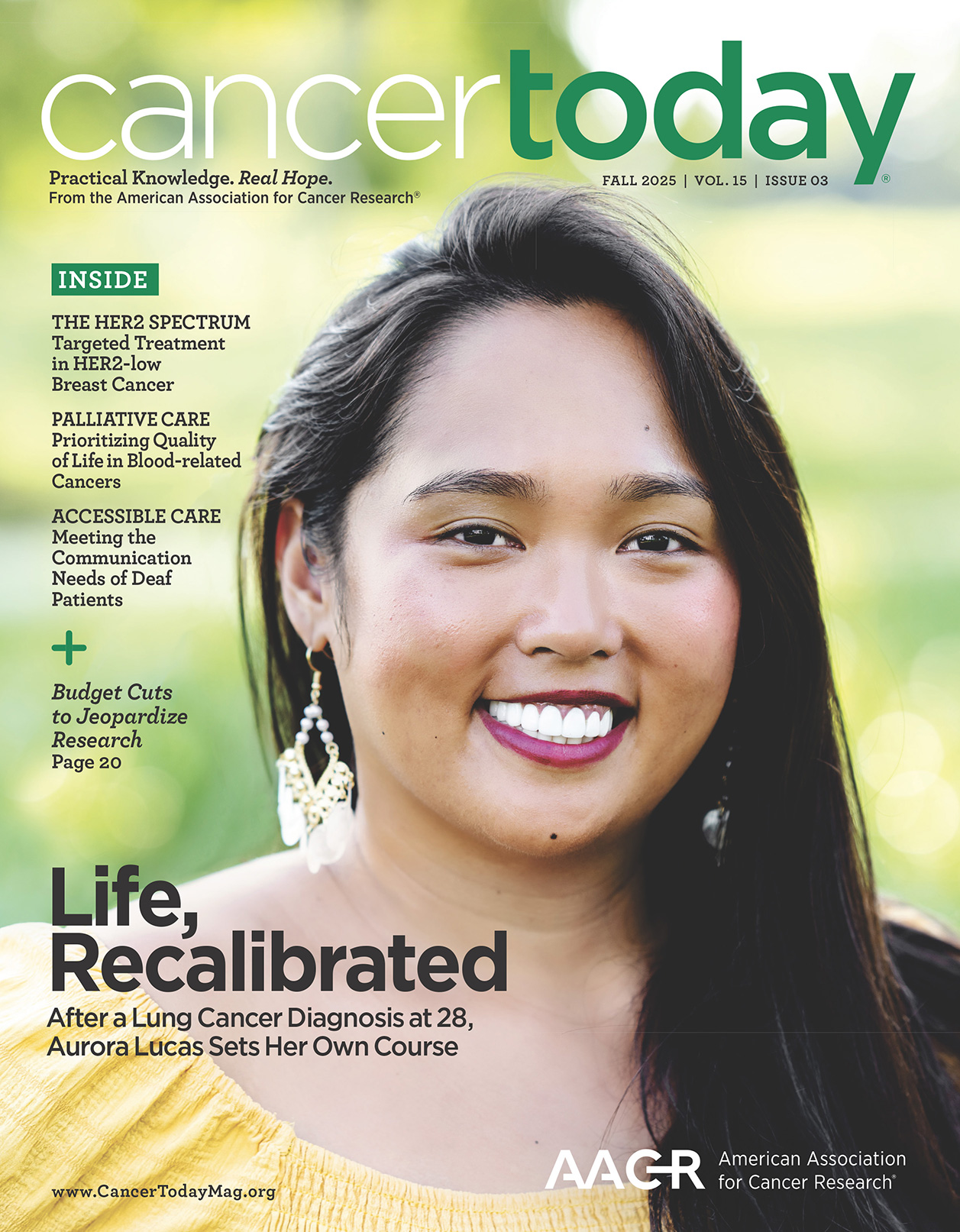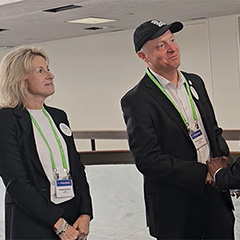PATIENT ADVOCATE Linda House is excited, but anxious, about big data and cancer care. House, president of the Washington, D.C.-based nonprofit Cancer Support Community, has made it her mission to protect the interests of patients. Like many advocates, she welcomes the emerging projects that aim to make cancer care more precise by pooling patient information in giant electronic databases. But she is concerned about how patients will be informed about the process and how big data might play a role in treatment decisions.
“How do we make sure we don’t lose the patient in the conversation?” she said at a town hall meeting about big data and cancer care attended by patients, providers, researchers and advocates in June 2015. The gathering, held in Alexandria, Virginia, was hosted by C-Change, an organization that brings together leaders from the cancer community. House moderated a panel on big data and patients.
“We can have all this data and pinpoint what might be the best treatment, but at the end, a patient’s beliefs and personal needs will shape whether they move forward with treatment,” House says. “We owe it to patients to not let them get lost in the groundswell.”

PHOTO © iStock / MmeEmil
Big-data projects offer a tantalizing, if unrealized and untested, view of the future of cancer care. Traditionally, oncologists recommend treatments that have been evaluated and approved based on clinical trials. But clinical trial findings are distilled from the experiences of a limited number of selected patients during a particular time period. Small trials may involve fewer than 100 patients. According to the National Cancer Institute, only a tiny slice of the U.S. adult patient population—a mere 3 percent—even enrolls in clinical trials for new and emerging therapies. But what if treatment decisions could be based on the experiences of millions of patients? That is the question at the heart of big data.
“It’s a missed opportunity if we don’t leverage all this data,” says medical oncologist and cancer researcher Charles Sawyers of Memorial Sloan Kettering Cancer Center in New York City, a past president of the American Association for Cancer Research (AACR).
The overarching idea is that data on large numbers of cancer patients and their tumors—recorded during the course of treatment—could be archived and analyzed all together. This approach could widen treatment options for an individual with a rare type of cancer or a cancer with a rare mutation. It might also point to better treatment options for an entire population of patients who share similar disease characteristics, like genetic mutations. And while Sawyers cautions that researchers are probably still at least a decade away from a better understanding of how to pull meaning from millions of patient records, a slew of big-data projects are underway at leading cancer research organizations and institutions. Researchers are building databases, designing algorithms to organize the data and search for patterns, and even enlisting IBM’s Watson, the computer that achieved fame by competing and winning $1 million on the game show Jeopardy!
The Power of Big Numbers
More than 14 million people in the U.S. currently have or had cancer at one time. In the next four years or so, that number is predicted to climb to 18 million. They all have or will have medical records, blood samples and tumor tissue samples. Every patient lives a unique cancer story that includes symptoms, diagnosis, treatments, genes, family history, tumor characteristics, outcomes and other factors. Information collected from millions of patients adds up to a lot of data. Big-data projects are investigating ways to collect and analyze these large amounts of information, with the goal of identifying previously unobserved connections that could improve cancer treatment.
Imagine, for example, a patient diagnosed with a rare cancer at a rural hospital—matched with an oncologist who, having never treated this type of cancer, consults an online tool that identifies a treatment that helped similar patients with the same rare cancer. Or consider a breast cancer patient whose tumor carries a genetic mutation more typically found in lung cancer, leading an oncologist to recommend a drug, perhaps off-label, that helped a subset of lung cancer patients with the same mutation.
These connections are rare. On the other hand, given the large number of people diagnosed with cancer, “there are a lot of patients who are in that scenario for common tumor types,” says Sawyers, who is currently heading AACR Project GENIE, the data-sharing project of the American Association for Cancer Research that links patients’ tumor genome data to their clinical outcomes. GENIE stands for Genomics, Evidence, Neoplasia, Information, Exchange.
Cancer is a disease that arises from accumulated genetic mutations. AACR Project GENIE was designed to ultimately allow clinicians who are deciding on a patient’s treatment regimen to look at past patient experiences and see how people with particular molecular tumor characteristics—including mutations—responded to certain treatments. In other words, the profile of a person’s tumor may help show if they’re likely to respond to treatment, develop resistance or have some other response.
At the project’s launch in November 2015, AACR Project GENIE contained more than 17,000 patient records; by 2020, Sawyers says, the AACR hopes to have 100,000 records in the registry. Seven large cancer institutions have signed on to AACR Project GENIE’s first phase, which consists of using the data to answer a research question, for example, whether a drug for a particular genetic variant in a certain cancer would also be effective for the same mutation in another kind of cancer.
Oncologist Mia Levy leads the AACR Project GENIE arm at Vanderbilt-Ingram Cancer Center in Nashville, Tennessee. She says AACR Project GENIE offers the promise of using new findings from the laboratory to improve patient care. “I have this database full of patient data and a new patient sitting in front of me today,” she says, referring to a typical example. “Is there a way to use that information to treat this patient I’m seeing right now? That’s the broad vision, and the holy grail of treatment.”
Right now, patient data are largely collected in separate institutional databases that are not shared, says former cancer researcher Shawn Sweeney, the AACR’s associate director of translational research, who is the AACR Project GENIE project lead. Historically, individual cancer centers and hospitals have by and large not shared data with other facilities—or even been able to do so, he says.
Learn some ways big data could make a difference.
Big-data projects that involve analyzing huge amounts of electronic data to identify meaningful connections have already been used to better understand cancer and its treatment. The Cancer Genome Atlas (TCGA), led by the National Institutes of Health, began in 2006 and has catalogued the genomes of more than 11,000 cancer cases. That genetic data, which is publicly available to researchers, has been used in a variety of studies. Now, there are a number of areas where experts think big data could make a difference.
- Generate new treatments. Computer models could analyze genetic and clinical data to identify molecules that have the highest probability of being turned into safe and effective treatments.
- Validate biomarkers. Cancer researchers regularly identify biomarkers—including genetic mutations—that seem to play an important role in the development or progression of cancer, or that may indicate the likelihood of a tumor’s response to treatment. By analyzing millions of similar cases, big-data projects could confirm the importance of these biomarkers or show that they’re not as significant as they once seemed.
- Identify populations of cancer patients most likely to respond to treatment. The more we learn about cancer, the more we know that it varies dramatically from person to person at the molecular level, even for cancers that originate from the same site. “We are getting smaller and smaller subpopulations, and we can’t design a clinical trial for every scenario,” says oncologist Mia Levy at the Vanderbilt-Ingram Cancer Center in Nashville, Tennessee. By combining genetic and clinical patient data, big-data algorithms may be able to identify which patients are most likely to benefit from a treatment and which ones should avoid it.
A Patient-Centered Approach
The “data” in big-data projects takes many forms, but it always comes from patients. Patients may agree to share clinical histories, including information about overall health and symptoms, or genetic information about healthy cells or tumor cells. They may donate tissue like blood or tumor samples to a biorepository or tumor bank to be studied and perhaps shared with other institutions. Data for these projects may include a patient’s treatment options and the reasons that these treatments may or may not have been selected. In some projects, the data may even include questions and answers from patients.
In order to get and use data, institutions must obtain informed consent from their patients—often given as broad permission to use genomic and tumor data in experiments and studies. Informed consent agreements should tell patients which data will be shared and which data will be kept private. Consent agreements should also inform patients that they can decide whether or not to share their data and indicate how the data will be protected. In the case of AACR Project GENIE, says Sawyers, participating institutions obtained an informed consent from their patients to use their data in experiments and studies.
Jim Omel, a retired physician in Grand Island, Nebraska, was diagnosed with multiple myeloma in 1997. He has spent nearly 20 years as a patient advocate and sees big data as a way for patients to participate in treatment research. He is a member of the patient advisory committee for CancerLinQ, a big-data project that will allow patients and physicians to share information about treatments and outcomes. In a 2013 prototype, the American Society of Clinical Oncology (ASCO) demonstrated how CancerLinQ would work, using about 170,000 records from breast cancer patients. Twelve sites, including cancer treatment centers, have signed on to share data through CancerLinQ, and ASCO says it expects the first tool to be online in 2016.
For physicians, a database like CancerLinQ can help provide cutting-edge treatment recommendations. “There’s way too much information [for doctors] to keep up with,” says oncologist Michael Neuss at Vanderbilt, who has advised ASCO on CancerLinQ. He says the project “provides real-time information to support the decisions of your doctor.” For example: If a cancer with a particular genetic mutation is found to develop resistance to a targeted drug, the oncologist may avoid that drug. CancerLinQ “will presumably tell me that quicker than I will learn it on my own,” Neuss says.
For patients, big-data projects offer the chance to participate in research that could improve treatment—maybe not for them, but for future generations. “The nice thing about CancerLinQ is that it captures all of this information that would otherwise be lost, just stored in local medical records,” says Omel. “Every patient’s treatment can become a part of our knowledge base about cancer, and patients buy into that idea. We want our treatment to be used to fight the scourge.”
Some projects that use the crowd-sourcing power of big data look at other aspects of a patient’s experience. The Cancer Support Community runs the Cancer Experience Registry, designed to identify the emotional and social needs of patients and caregivers. Participants log in and answer questions on the social, emotional, and financial consequences of their diagnoses and treatment decisions.
“Once you answer a question, you can click and see how others like you answered the same question,” says House. “There’s an immediate feeling of community.”
Another Web-based network, Patients Like Me, similarly allows patients to connect with and learn from other patients.
Privacy Concerns
A lingering issue that troubles some patients is protecting a person’s privacy by making data anonymous. Big-data projects like AACR Project GENIE and CancerLinQ have implemented strategies to de-identify data, which means a patient’s name and other identifying information are removed from records of their disease.
However, “no matter how much you tell people they’re going to be de-identified, they’re still going to be worried,” says retired teacher Cindy Chmielewski of Lawrenceville, New Jersey, who became a patient advocate and educator after being diagnosed with stage III multiple myeloma in 2008. That fear is particularly pronounced in working-age adults, she has found. “They’re worried that their livelihood will be affected,” Chmielewski says, adding that some people are concerned about their employers discovering their health problems—through a data leak, for instance—potentially placing their jobs in jeopardy.
Chmielewski supports big-data projects and encourages newly diagnosed patients to get involved and offer as much information as they’re comfortable divulging. At the same time, she is adamant that research projects, from clinical trials to big data, make every effort to protect patient data and tell patients how their information has been used. Chmielewski would like patients to be able to ask for and receive results from studies that use their data.
“We want to be involved, we want to have a voice and we want to be informed about how it’s going,” she says of patients. “Don’t just take our information and walk away with it.”
House agrees, although she notes that sharing data with every participant is a tall order. She says patients should be told at the beginning of their treatment what to expect if they agree to share their data and how it might contribute to research. Patients also will need to be clear about their goals for treatment before deciding whether to go forward with a treatment decision based on data.
“You as a patient need to ask really thoughtful questions, to make sure the objective of the [big-data] project aligns with your subjective expectations,” she says. It’s possible that objective treatment recommendations from such a project won’t line up with a patient’s subjective goals.
House says she celebrates the idea that a physician can collect data on a patient and come back with a treatment recommendation based on the experience of thousands of other patients. At the same time, she says, decisions about treatment and sharing disease data ultimately come down to a patient’s personal needs and situation. As a researcher and a patient advocate, she sees big data from both sides.
“The scientist in me says ‘Yes, we would love to have everything and we need it all. It will shape and inform care in the future,’ ” says House. “But from a patient perspective, it’s a very personal decision” to share data.
Big-data projects have the potential to dramatically change the experience of a person with cancer by fine-tuning cancer treatment to the unique molecular profile of the tumor. Sawyers says he looks forward to the day when patients who receive a cancer diagnosis can also receive a genomic report—one that can tell them what those mutations mean in terms of prognosis and which treatments are likely to be most effective.
“Right now, with a few exceptions, it’s a bit of a guessing game” to know how a particular tumor will respond to treatment. Big data, he says, has the potential to eliminate that guesswork.
Cancer Today magazine is free to cancer patients, survivors and caregivers who live in the U.S. Subscribe here to receive four issues per year.




